Evaluating Complex Magma Mixing via Polytopic Vector Analysis (PVA) in the Papagayo Tuff, Northern Costa Rica: Processes that Form Continental Crust
Abstract
:1. Introduction
2. Geologic and Tectonic Setting
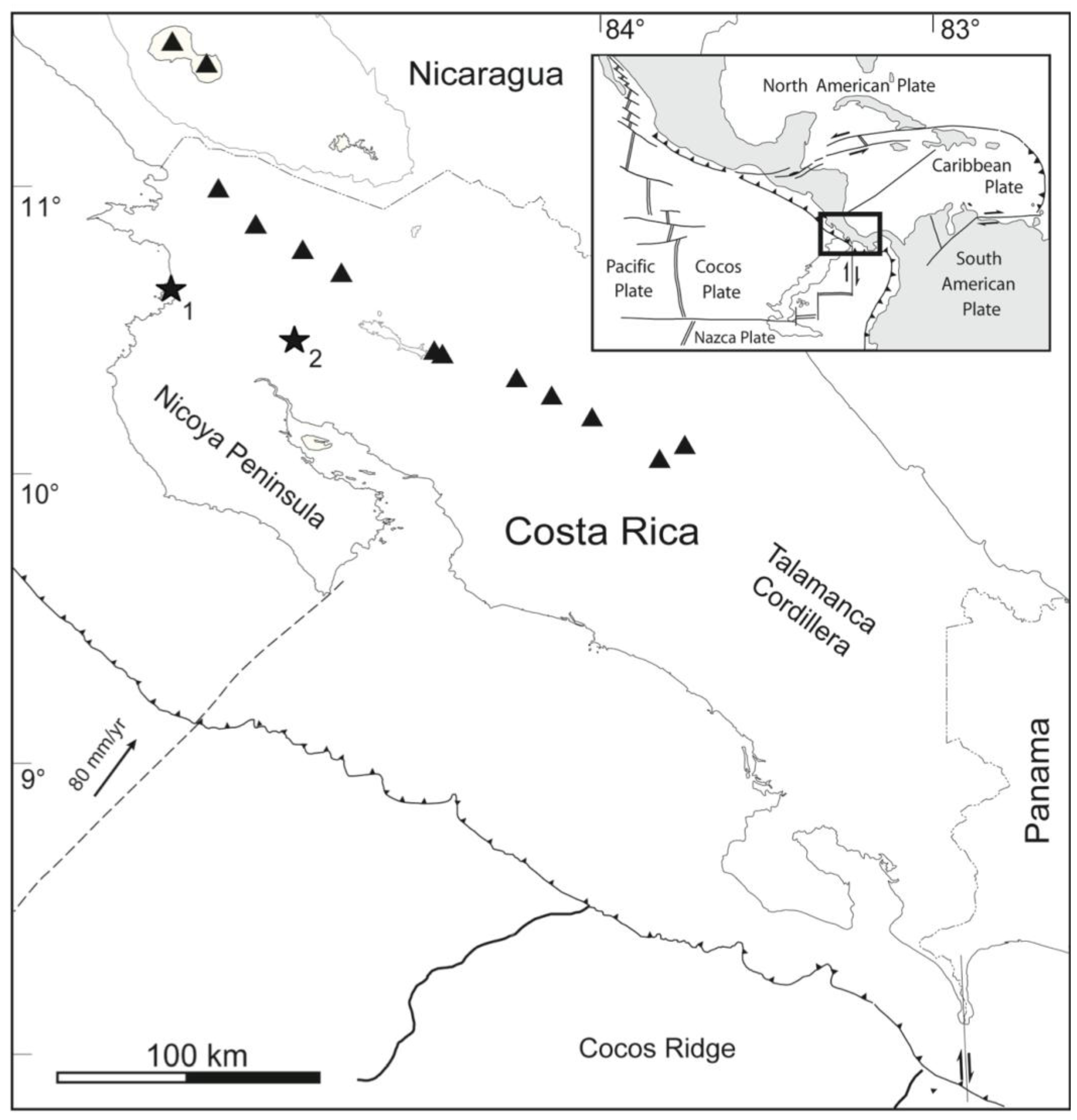
2.1. Significance of Ignimbrites in the Bagaces Formation: Evolving Continental Crust?
3. Analytical Methods
4. The Papagayo Tuff

4.1. Pumice Chemistry and Petrography

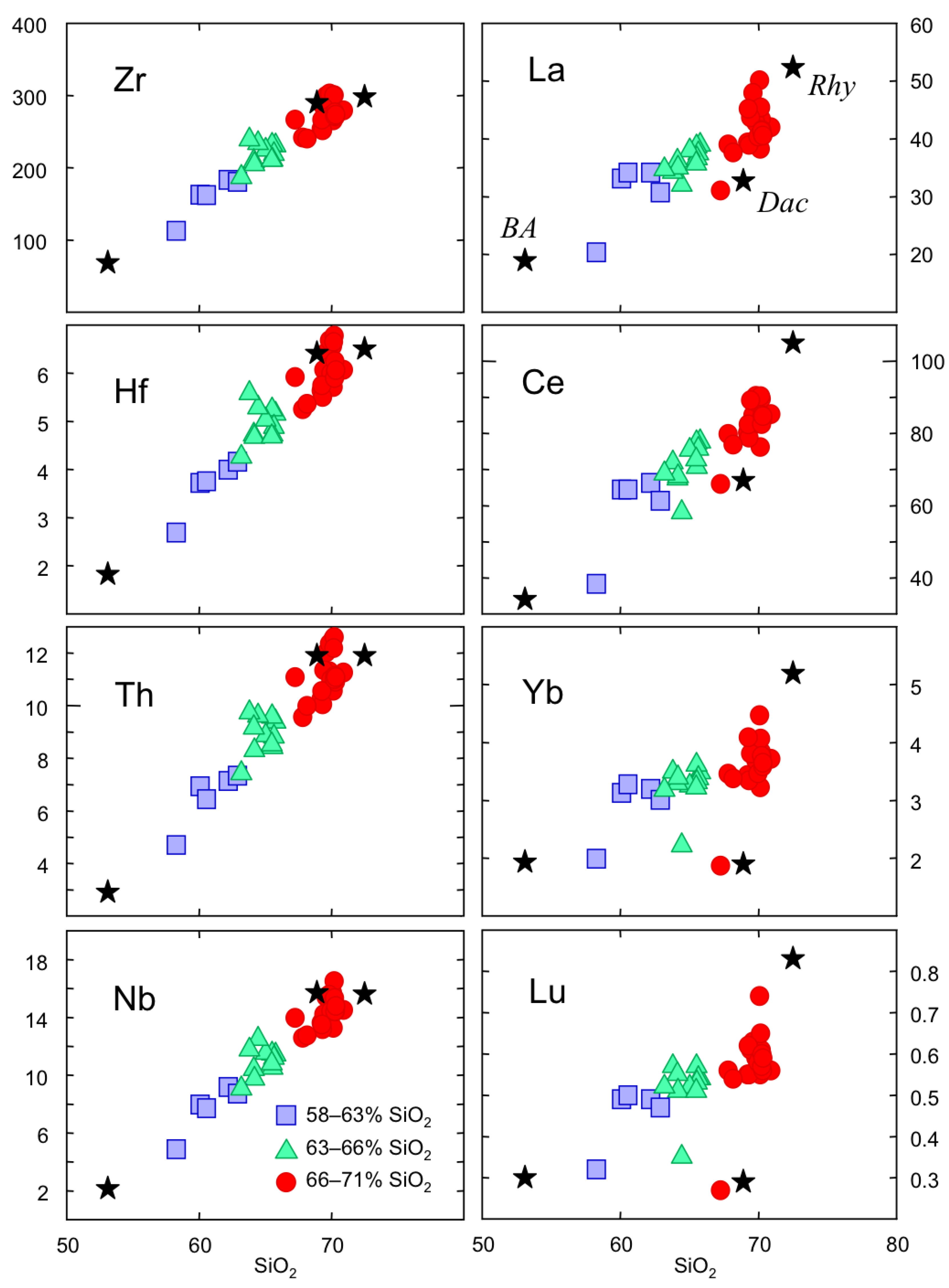
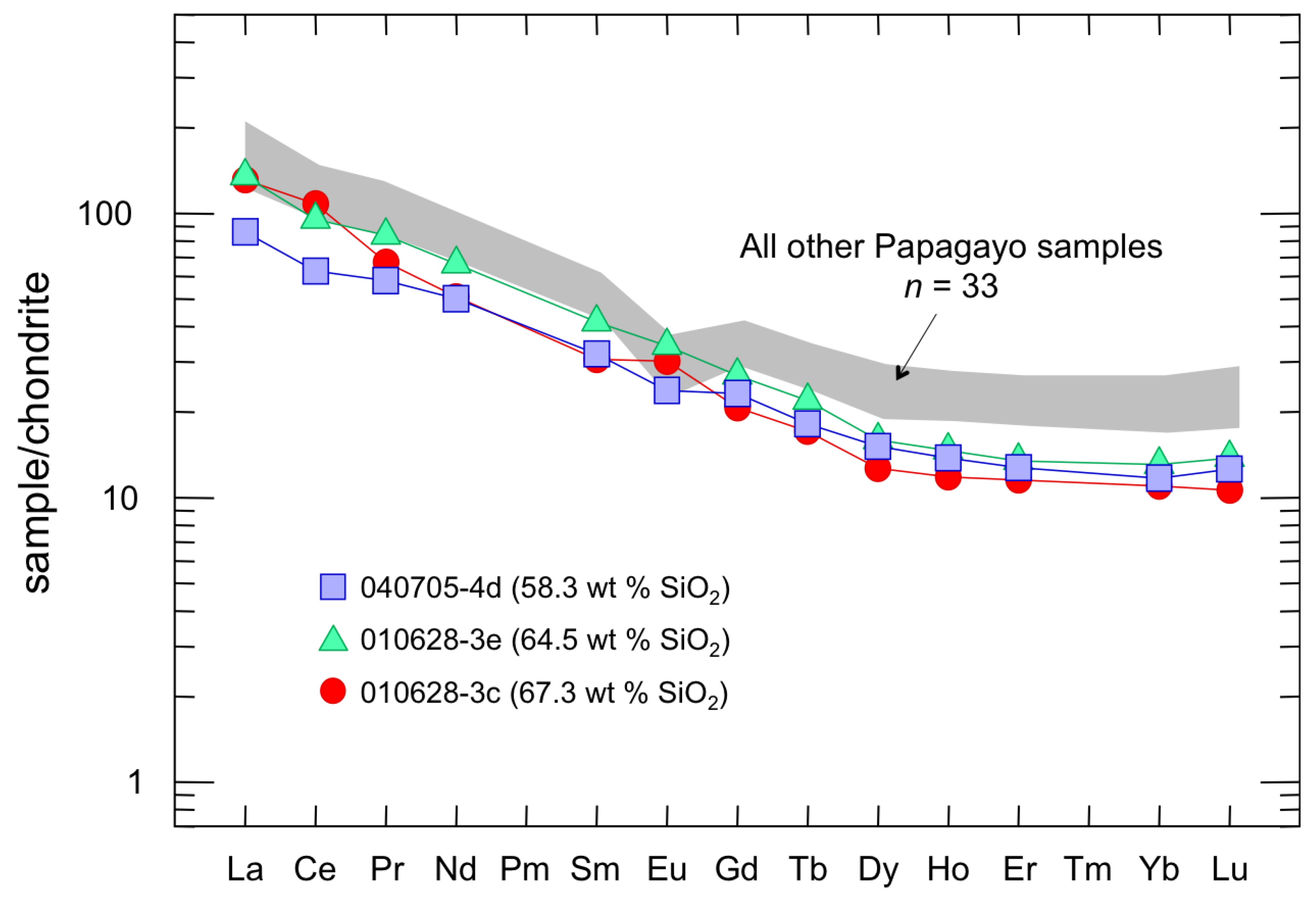
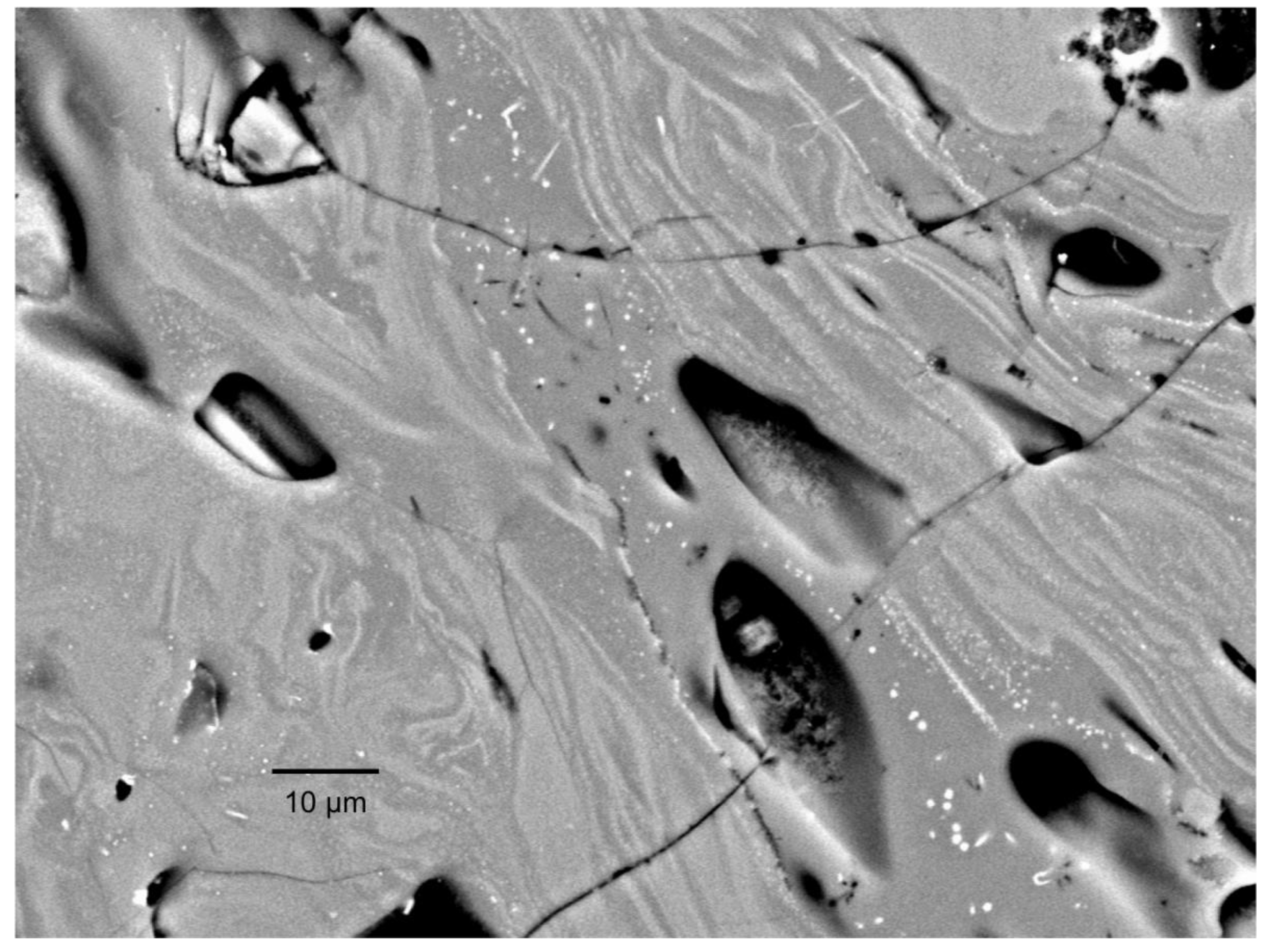
4.2. Matrix Glass Composition


4.3. Mineral Compositions
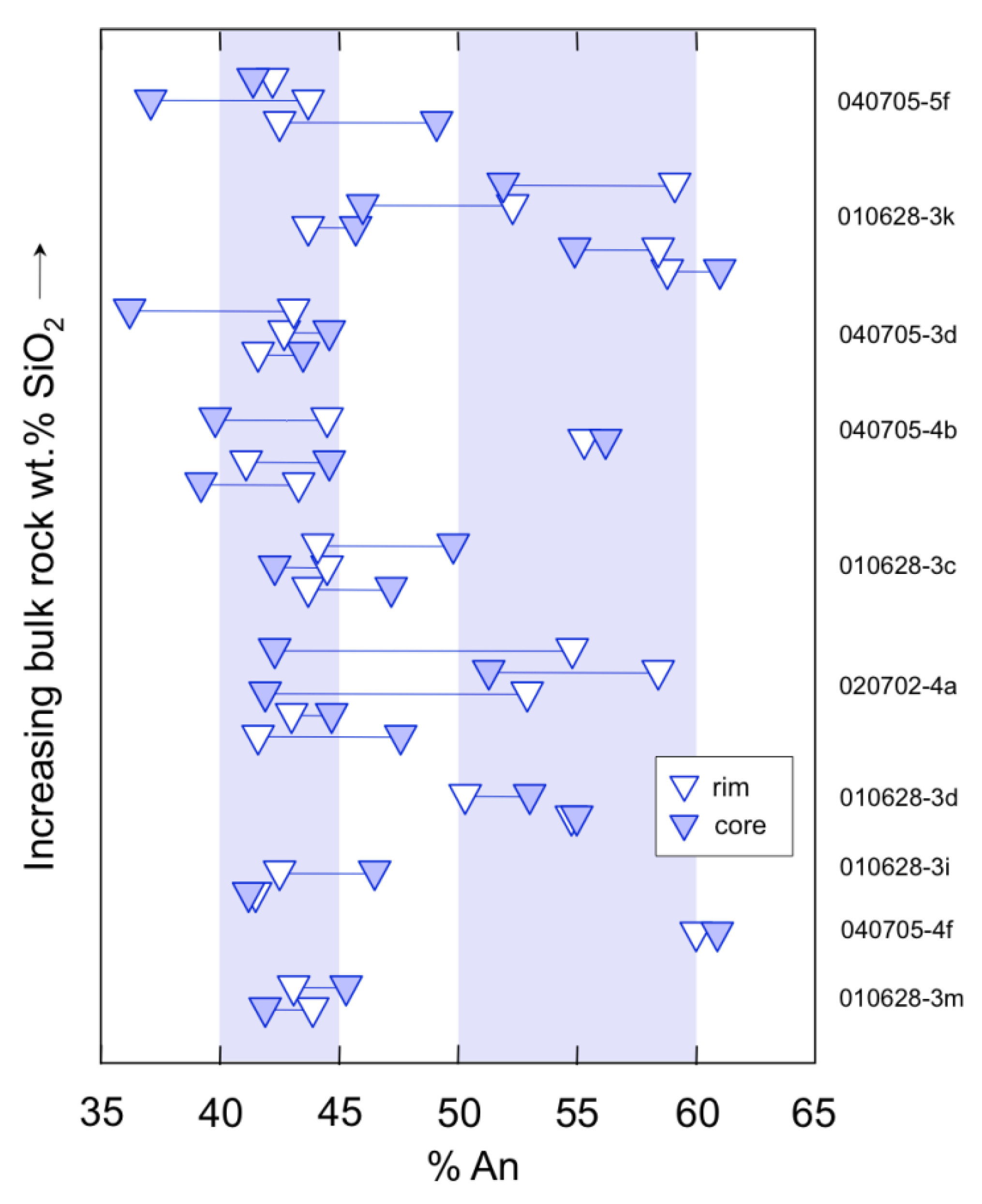
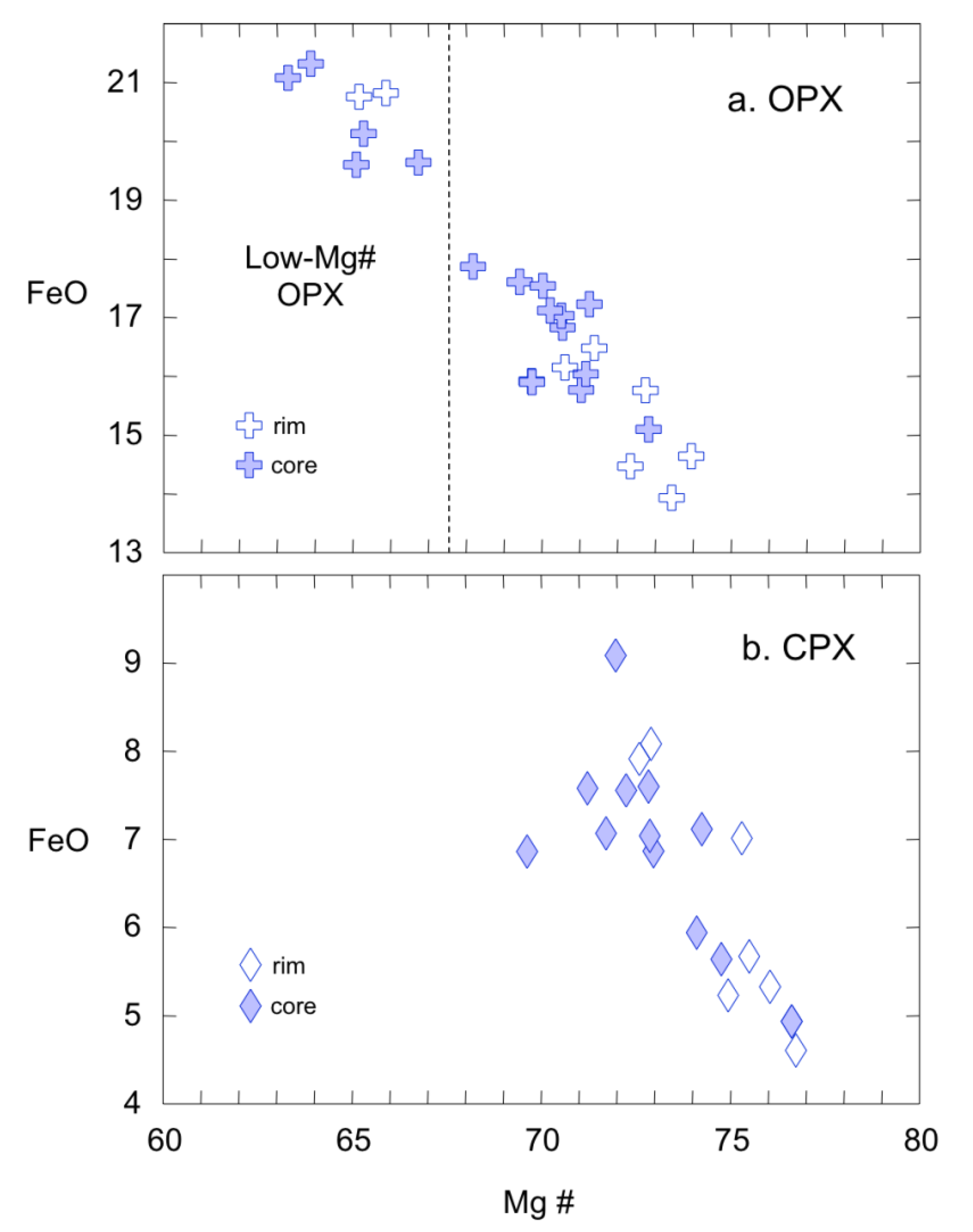
5. Discussion
5.1. Magma Mixing in the Papagayo Tuff
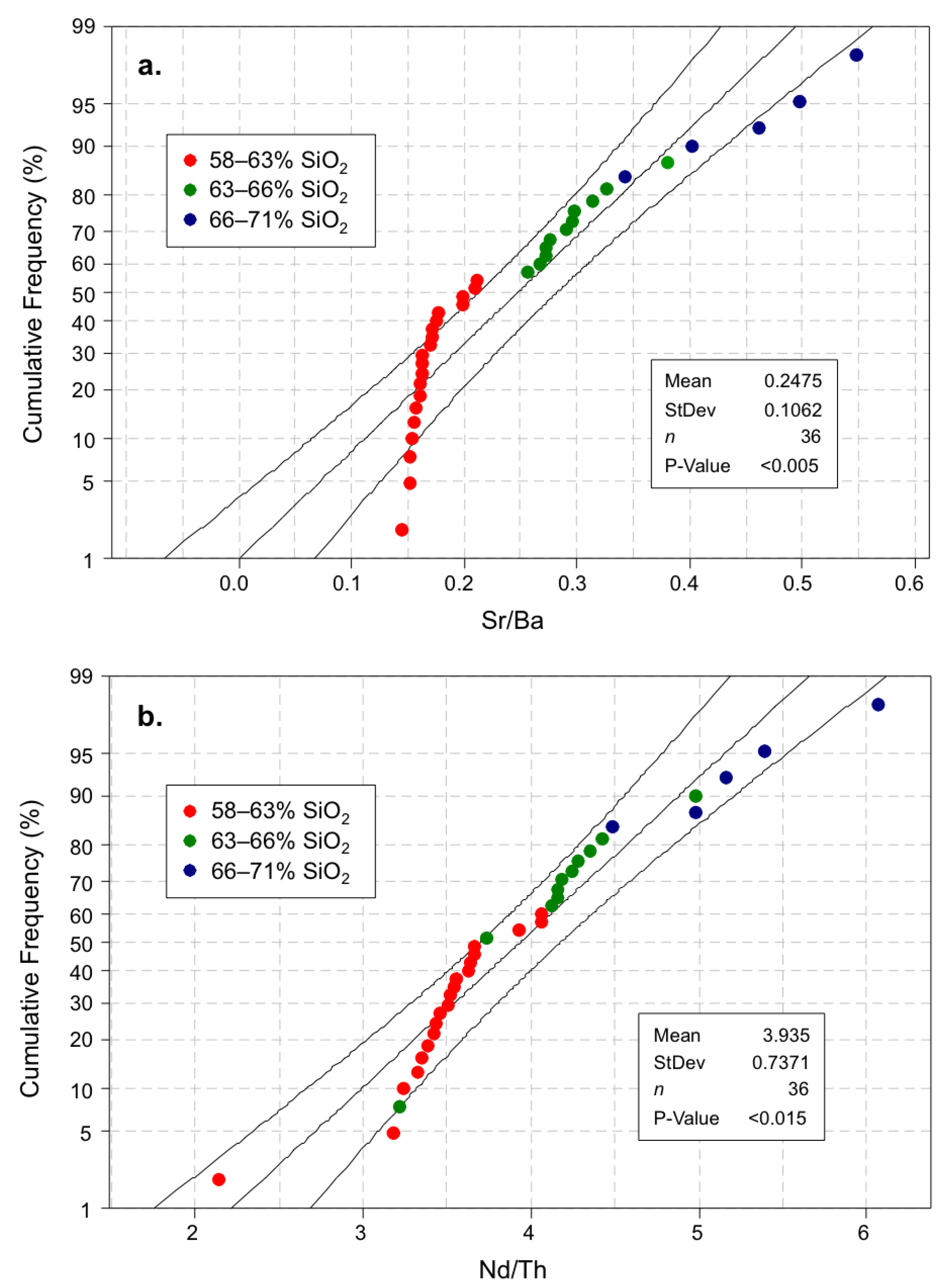
5.2. Origin of the “Anomalous” Samples
5.3. Polytopic Vector Analysis (PVA)
5.3.1. PVA of the Papagayo Samples
| Analyte | 2 | 3 | 4 |
|---|---|---|---|
| SiO2 | 0.96 | 0.98 | 0.99 |
| TiO2 | 0.86 | 0.88 | 0.93 |
| Al2O3 | 0.70 | 0.81 | 0.79 |
| Fe2O3 | 0.96 | 0.97 | 0.98 |
| MnO | 0.39 | 0.61 | 0.64 |
| MgO | 0.85 | 0.95 | 0.97 |
| CaO | 0.91 | 0.96 | 0.98 |
| Na2O | 0.03 | 0.13 | 0.86 |
| K2O | 0.89 | 0.93 | 0.95 |
| P2O5 | 0.84 | 0.92 | 0.93 |
| Rb | 0.70 | 0.85 | 0.91 |
| Sr | 0.88 | 0.90 | 0.95 |
| Sr | 0.92 | 0.93 | 0.95 |
| Ba | 0.78 | 0.90 | 0.94 |
| La | 0.70 | 0.81 | 0.95 |
| Ce | 0.82 | 0.90 | 0.93 |
| Pr | 0.51 | 0.79 | 0.95 |
| Nd | 0.25 | 0.70 | 0.93 |
| Sm | 0.18 | 0.67 | 0.91 |
| Eu | 0.05 | 0.07 | 0.84 |
| Gd | 0.10 | 0.68 | 0.88 |
| Tb | 0.16 | 0.68 | 0.88 |
| Y | 0.22 | 0.81 | 0.93 |
| Dy | 0.13 | 0.75 | 0.89 |
| Ho | 0.18 | 0.78 | 0.90 |
| Er | 0.27 | 0.82 | 0.93 |
| Yb | 0.39 | 0.86 | 0.95 |
| Lu | 0.38 | 0.84 | 0.93 |
| V | 0.89 | 0.90 | 0.91 |
| Nb | 0.92 | 0.94 | 0.96 |
| Hf | 0.89 | 0.91 | 0.92 |
| Ta | 0.87 | 0.92 | 0.92 |
| Pb | 0.50 | 0.52 | 0.59 |
| Th | 0.88 | 0.90 | 0.93 |
| U | 0.82 | 0.82 | 0.87 |
| Analyte | Rhy | BA | Dac |
|---|---|---|---|
| SiO2 | 72.5 | 53.1 | 68.9 |
| TiO2 | 0.58 | 1.17 | 0.72 |
| Al2O3 | 13.40 | 19.00 | 16.90 |
| Fe2O3 | 2.18 | 11.40 | 4.20 |
| MnO | 0.13 | 0.19 | 0.06 |
| MgO | 0.66 | 2.95 | 0.02 |
| CaO | 1.79 | 7.29 | 1.58 |
| Na2O | 2.80 | 3.74 | 3.95 |
| K2O | 5.54 | 0.31 | 3.39 |
| P2O5 | 0.12 | 0.60 | 0.00 |
| Rb | 128.0 | 11.1 | 51.9 |
| Zr | 298.0 | 68.2 | 290.0 |
| Sr | 217.0 | 734.0 | 329.0 |
| V | 0.0 | 190.0 | 43.7 |
| Y | 50.80 | 23.70 | 18.40 |
| Nb | 15.60 | 2.14 | 15.70 |
| Ba | 1680 | 809 | 2130 |
| La | 52.30 | 18.90 | 32.70 |
| Ce | 105.00 | 34.00 | 66.90 |
| Pr | 13.60 | 5.61 | 6.98 |
| Nd | 51.50 | 26.70 | 24.70 |
| Sm | 9.92 | 5.64 | 4.88 |
| Eu | 1.68 | 1.89 | 1.68 |
| Gd | 9.01 | 5.51 | 4.27 |
| Tb | 1.39 | 0.79 | 0.64 |
| Dy | 7.91 | 4.31 | 3.10 |
| Ho | 1.69 | 0.85 | 0.65 |
| Er | 4.91 | 2.21 | 1.86 |
| Yb | 5.19 | 1.93 | 1.90 |
| Lu | 0.83 | 0.30 | 0.29 |
| Hf | 6.50 | 1.82 | 6.41 |
| Ta | 0.91 | 0.02 | 1.01 |
| Pb | 10.00 | 1.86 | 9.53 |
| Th | 11.90 | 2.90 | 11.90 |
| U | 5.36 | 0.63 | 4.32 |
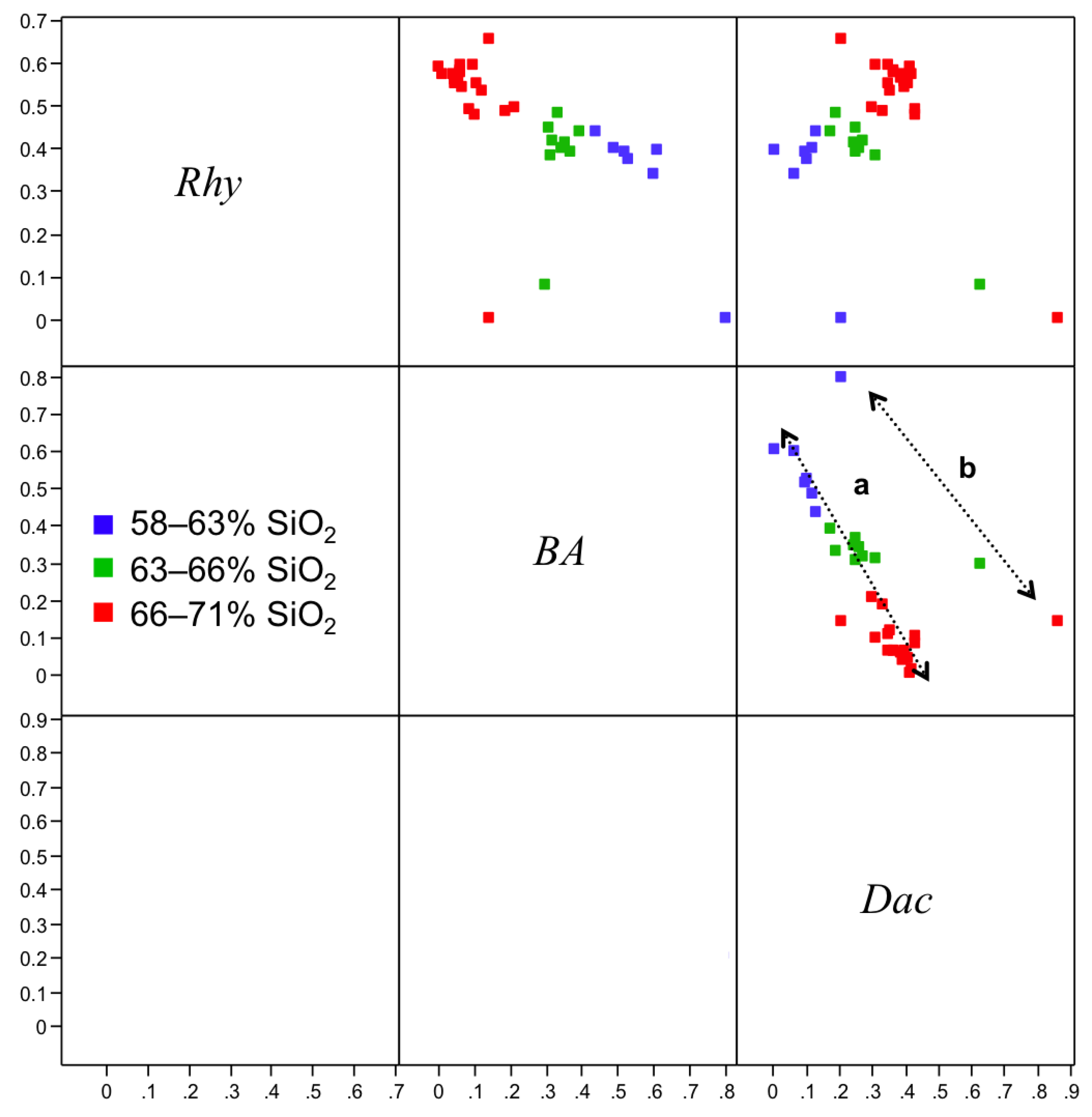
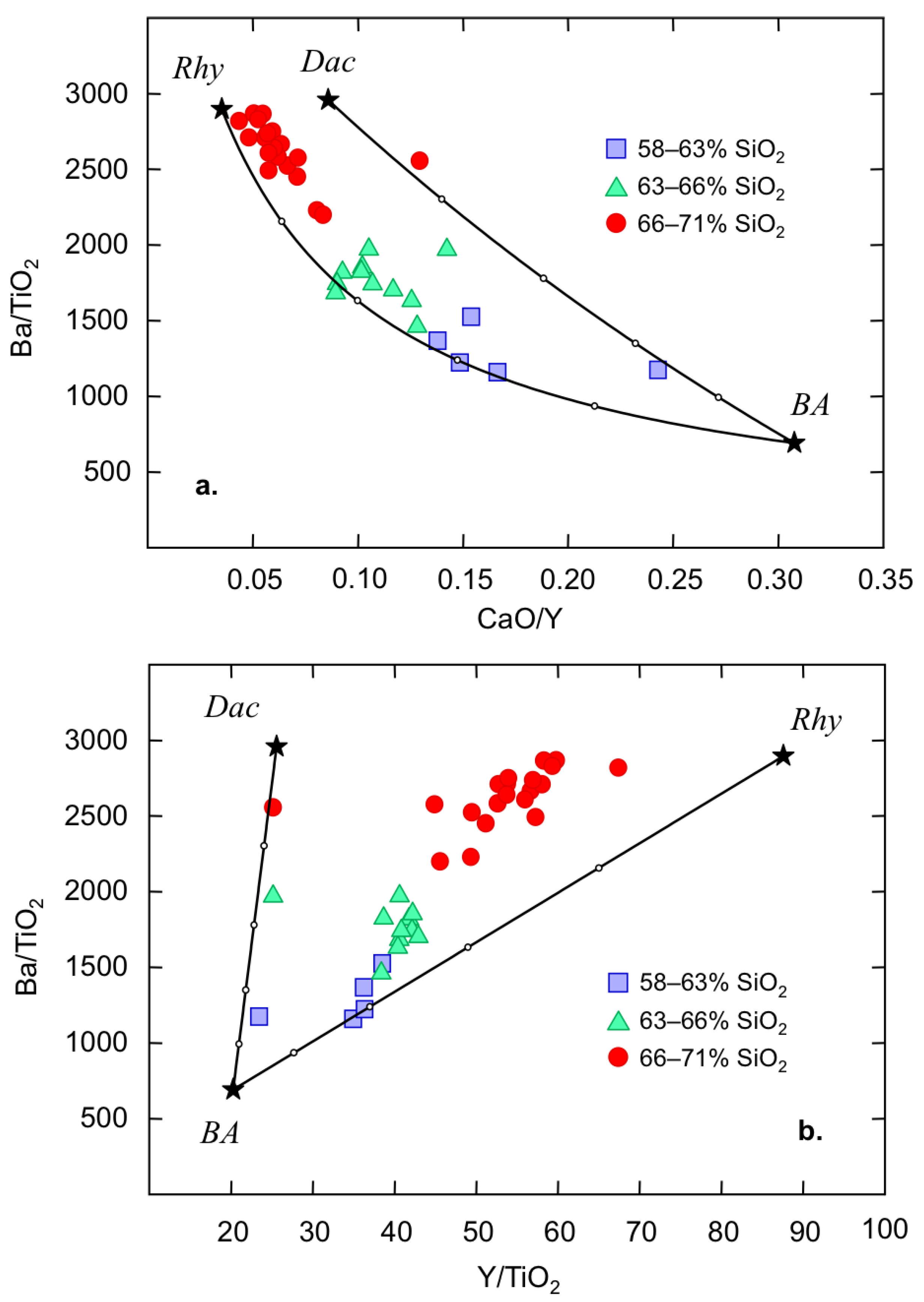
5.4. Petrogenesis of the Papagayo Tuff
5.5. Magma Mixing as a Process in the Formation of Continental Crust
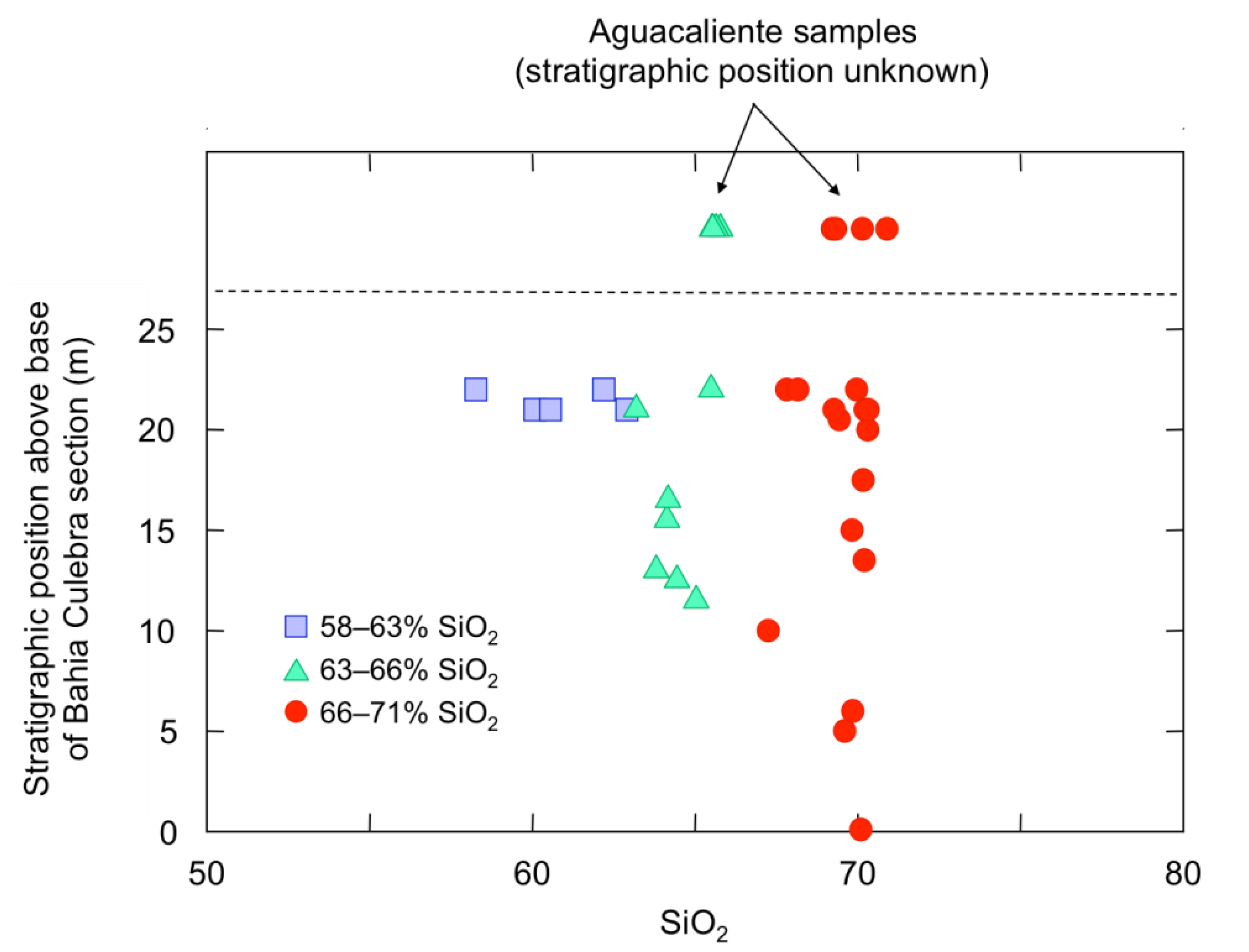
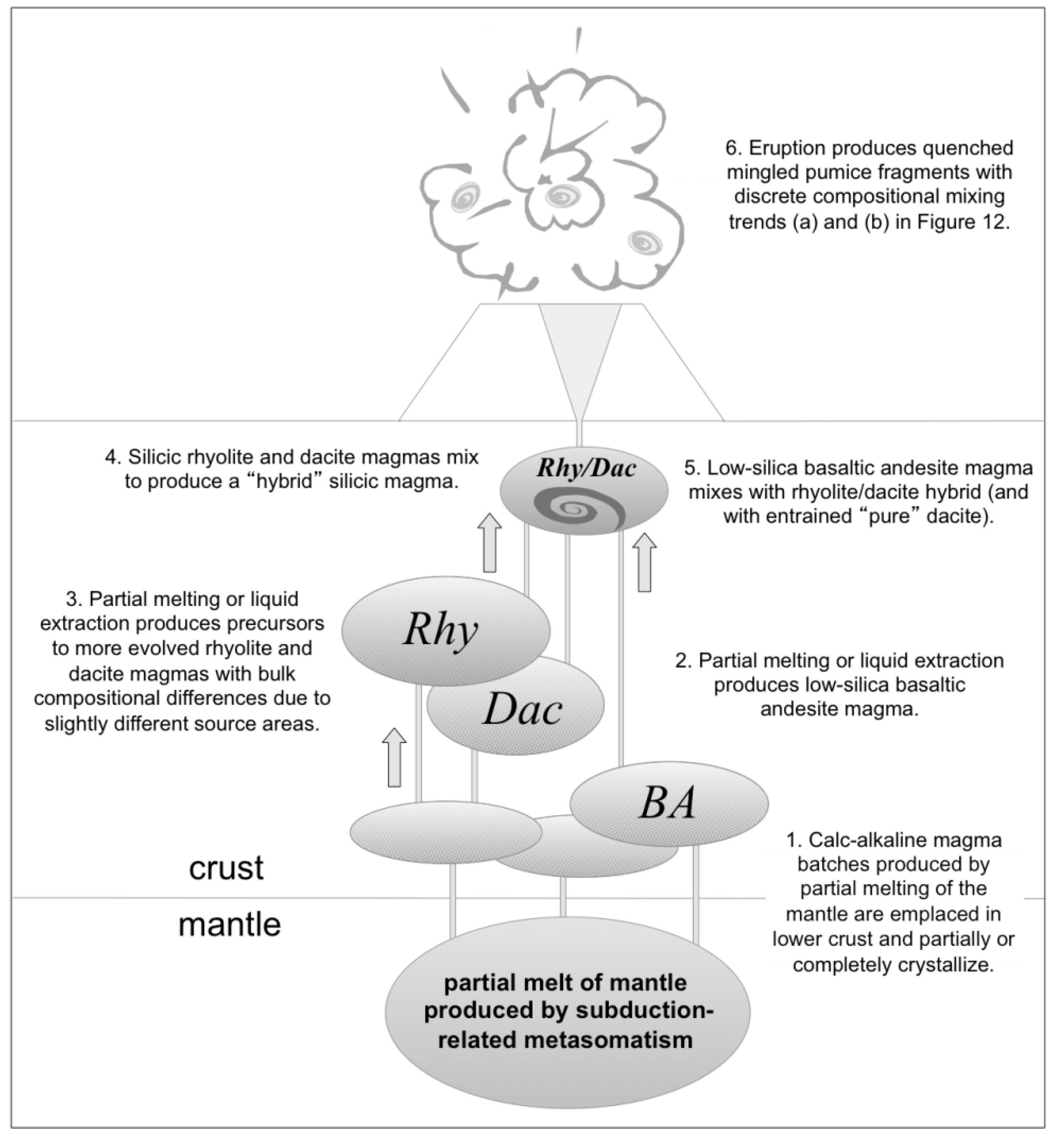

6. Conclusions
Acknowledgments
Conflicts of Interest
References
- Davidson, J.P.; Hora, J.M.; Garrison, J.M.; Dungan, M.A. Crustal forensics in arc magmas. J. Volcanol. Geotherm. Res. 2005, 140, 157–170. [Google Scholar] [CrossRef]
- Eichelberger, J.C. Vesiculation of mafic magma during replenishment of silicic magma reservoirs. Nature 1980, 288, 446–450. [Google Scholar] [CrossRef]
- Eichelberger, J.C.; Chertkoff, D.G.; Dreher, S.T.; Nye, C.J. Magmas in collision: Rethinking chemical zonation in silicic magmas. Geology 2000, 28, 603–606. [Google Scholar] [CrossRef]
- Murphy, M.D.; Sparks, R.S.J.; Barclay, J.; Carroll, M.R.; Lejeune, A.-M.; Brewer, T.S.; Macdonald, R.; Black, S.; Young, S. The role of magma mixing in triggering the current eruption at the Soufriere Hills volcano, Montserrat, West Indies. Geophys. Res. Lett. 1998, 25, 3433–3436. [Google Scholar] [CrossRef]
- Ruprecht, P.; Bachmann, O. Pre-eruptive reheating during magma mixing at Quizapu volcano and the implications for the explosiveness of silicic arc volcanoes. Geology 2010, 38, 919–922. [Google Scholar] [CrossRef]
- Sparks, S.R.J.; Sigurdsson, H. Magma mixing: A mechanism for triggering acid explosive eruptions. Nature 1977, 267, 315–318. [Google Scholar] [CrossRef]
- Wiebe, R.A. Rupture and inflation of a basic magma chamber by silicic liquid. Nature 1987, 326, 69–71. [Google Scholar] [CrossRef]
- D’Lemos, R.S. Mixing between granitic and dioritic crystal mushes, Guernsey, Channel Islands, UK. Lithos 1996, 38, 233–257. [Google Scholar] [CrossRef]
- De Silva, S.; Salas, G.; Schubring, S. Triggering explosive eruptions: The case for silicic magma recharge at Huaynaputina, southern Peru. Geology 2008, 36, 387–390. [Google Scholar] [CrossRef]
- Dungan, M.A. Open system magmatic evolution of the Taos Plateau volcanic field, northern New Mexico: II. The genesis of cryptic hybrids. J. Petrol. 1987, 28, 955–977. [Google Scholar] [CrossRef]
- Humphreys, M.C.S.; Blundy, J.D.; Sparks, R.S.J. Magma evolution and open-system processes at Shiveluch Volcano: Insights from phenocryst zoning. J. Petrol. 2006, 47, 2303–2334. [Google Scholar] [CrossRef]
- Ruprecht, P.; Wörner, G. Variable regimes in magma systems documented in plagioclase zoning patterns: El Misti stratovolcano and Andahua monogenetic cones. J. Volcanol. Geotherm. Res. 2007, 165, 142–162. [Google Scholar] [CrossRef]
- Browne, B.L.; Eichelberger, J.C.; Patino, L.C.; Vogel, T.A.; Uto, K.; Hoshizumi, H. Magma mingling as indicated by texture and Sr/Ba ratios of plagioclase phenocrysts from Unzen volcano, SW Japan. J. Volcanol. Geotherm. Res. 2006, 154, 103–116. [Google Scholar] [CrossRef]
- Davidson, J.P.; Tepley, F.J., III. Recharge in volcanic systems: Evidence from isotope profiles of phenocrysts. Science 1997, 275, 826–829. [Google Scholar] [CrossRef]
- Feeley, T.C.; Dungan, M.A. Compositional and dynamic controls on mafic-silicic magma interactions at continental arc volcanoes: Evidence from cordón el guadal, tatara-san pedro complex, Chile. J. Petrol. 1996, 37, 1547–1577. [Google Scholar] [CrossRef]
- Izbekov, P.E.; Eichelberger, J.C.; Patino, L.C.; Vogel, T.A.; Ivanov, B.V. Calcic cores of plagioclase phenocrysts in andesite from Karymsky volcano: Evidence for rapid introduction by basaltic replenishment. Geology 2002, 30, 799–802. [Google Scholar] [CrossRef]
- Barclay, J.; Herd, R.A.; Edwards, B.R.; Christopher, T.; Kiddle, E.J.; Plail, M.; Donovan, A. Caught in the act: Implications for the increasing abundance of mafic enclaves during the recent eruptive episodes of the Soufrière Hills Volcano, Montserrat. Geophys. Res. Lett. 2010, 37, L00E09:1–L00E09:5. [Google Scholar] [CrossRef]
- Tefend, K.S.; Vogel, T.A.; Flood, T.P.; Ehrlich, R. Identifying relationships among silicic magma batches by polytopic vector analysis: A study of the Topopah Spring and Pah Canyon ash-flow sheets of the southwest Nevada volcanic field. J. Volcanol. Geotherm. Res. 2007, 167, 198–211. [Google Scholar] [CrossRef]
- Vogel, T.A.; Hidalgo, P.J.; Patino, L.; Tefend, K.S.; Ehrlich, R. Evaluation of magma mixing and fractional crystallization using whole-rock chemical analyses: Polytopic vector analyses. Geochem. Geophys. Geosyst. 2008, 9. [Google Scholar] [CrossRef]
- Rogers, R.D.; Mann, P.; Emmet, P.A. Tectonic Terranes of the Chortis Block Based on an Integration of Regional Aeromagnetic and Geologic Data. In Geologic and Tectonic Development of the Caribbean Plate Boundary in Northern Central America; GSA Special Papers 428; Mann, P., Ed.; Geological Society of America: Boulder, CA, USA, 2007; pp. 65–88. [Google Scholar]
- MacKenzie, L.; Abers, G.A.; Fischer, K.M.; Syracuse, E.M.; Protti, J.M.; Gonzalez, V.; Strauch, W. Crustal structure along the southern Central American volcanic front. Geochem. Geophys. Geosyst. 2008, 9. [Google Scholar] [CrossRef]
- Linkimer, L.; Beck, S.L.; Schwartz, S.Y.; Zandt, G.; Levin, V. Nature of crustal terranes and the Moho in northern Costa Rica from receiver function analysis. Geochem. Geophys. Geosyst. 2010, 11. [Google Scholar] [CrossRef]
- Sinton, C.W.; Duncan, R.A.; Storey, M.; Lewis, J.; Estrada, J.J. An oceanic flood basalt province within the Caribbean plate. Earth Planet. Sci. Lett. 1998, 155, 221–235. [Google Scholar] [CrossRef]
- Marshall, J.S. The Geomorphology and Physiographic Provinces of Central America. In Central America: Geology, Resources and Hazards; Bundschuh, J., Alvarado, G.E., Eds.; Taylor and Francis: London, UK, 2007; pp. 1–51. [Google Scholar]
- Dengo, G. Tectonic-Igneous Sequence in Costa Rica. In Petrologic Studies: A Volume to Honor A.F. Buddington; Engel, A.E.J., James, H.L., Leonard, B.F., Eds.; Geological Society of America: Boulder, CA, USA, 1962; pp. 133–161. [Google Scholar]
- Kussmaul, S.; Tournon, J.; Alvarado, G.E. Evolution of the Neogene to Quaternary igneous rocks of Costa Rica. Profil 1994, 7, 97–123. [Google Scholar]
- Tournon, J. Magmatismes du Mesozoique a l’actuel en Amérique Central: L’example de Costa Rica, des ophiolites aux andesites; [in French]; Université Curie: Paris, France, 1984. [Google Scholar]
- Chiesa, S.; Civelli, G.; Gillot, P.-Y.; Mora, O.; Alvarado, G.E. Rocas piroclásticas asociadas con la Formación de la caldera Guayabo, cordillera de Guanacaste, Costa Rica. [in Spanish]. Rev. Geol. Am. Central 1992, 14, 59–75. [Google Scholar]
- Aguilar, T.; Alvarado, G.E. Tafonomía y sedimentología de la paleobiota estuarina en los Cerros Barbudal (Costa Rica) sepultada por vulcanismo neógeno. [in Spanish]. Rev. Geol. Am. Cent. 2004, 30, 111–116. [Google Scholar]
- Gillot, P.-Y.; Chiesa, S.; Alvarado, G.E. Chronostratigraphy of upper Miocene-Quaternary volcanism in northern Costa Rica. Rev. Geol. Am. Cent. 1994, 17, 45–53. [Google Scholar]
- Alvarado, G.E.; Kussmaul, S.; Chiesa, S.; Gillot, P.-Y.; Appel, H.; Wörner, G.; Rundle, C. Resumen cronoestratigráfico de las rocas ígneas de Costa Rica basado en dataciones radiométricas. [in Spanish]. J. S. Am. Earth Sci. 1992, 6, 151–168. [Google Scholar] [CrossRef]
- Alvarado, G.E.; Gans, P.B. Sintesis geochronologica del magmatismo, metamorfismo y metalogenia de Costa Rica, America Central. [in Spanish]. Rev. Geol. Am. Cent. 2012, 46, 7–122. [Google Scholar]
- Appel, H.; Wörner, G.; Alvarado-Induni, G.E.; Rundle, C.; Kussmaul-Ruf, S. Age relations in igneous rocks from Costa Rica. Profil 1994, 7, 63–69. [Google Scholar]
- Gans, P.B.; Alvarado-Induni, G.; Perez, W.; MacMillan, I.; Calvert, A. Neogene Evolution of the Costa Rican Arc and Development of the Cordillera Central; Geological Society of America: Boulder, CA, USA, 2003. [Google Scholar]
- Vogel, T.A.; Patino, L.C.; Alvarado, G.E.; Gans, P.B. Silicic ignimbrites within the Costa Rican volcanic front: Evidence for the formation of continental crust. Earth Planet. Sci. Lett. 2004, 226, 149–159. [Google Scholar] [CrossRef]
- Denyer, P.; Alvarado, G.E. Mapa Geológico de Costa Rica; [in Spanish]; Librería Francesa: San Jose, Costa Rica, 2007. [Google Scholar]
- Hayes, J.L.; Holbrook, W.S.; Lizarralde, D.; van Avendonk, H.J.A.; Bullock, A.D.; Mora, M.; Harder, S.; Alvarado, G.E.; Ramirez, C. Crustal structure across the Costa Rican Volcanic Arc. Geochem. Geophys. Geosyst. 2013, 14, 1087–1103. [Google Scholar]
- Sallarès, V.; Dañobieta, J.J.; Flueh, E.R. Lithospheric structure of the Costa Rican Isthmus: Effects of subduction zone magmatism on an oceanic plateau. J. Geophys. Res. Sol. Ea. 2001, 106, 621–643. [Google Scholar] [CrossRef]
- Vogel, T.A.; Patino, L.C.; Eaton, J.K.; Valley, J.K.; Rose, W.I.; Alvarado, G.E.; Viray, E.L. Origin of silicic magmas along the Central American volcanic front: Genetic relationship to mafic melts. J. Volcanol. Geotherm. Res. 2006, 156, 217–228. [Google Scholar] [CrossRef]
- Leat, P.T.; Smellie, J.L.; Millar, I.L.; Larter, R.D. Magmatism in the South Sandwich Arc. Geol. Soc. Lond. Spec. Publ. 2003, 219, 285–313. [Google Scholar] [CrossRef]
- Smith, I.E.M.; Worthington, T.J.; Stewart, R.B.; Price, R.C.; Gamble, J.A. Felsic volcanism in the Kermadec arc, SW Pacific: Crustal recycling in an oceanic setting. Geol. Soc. Lond. Spec. Publ. 2003, 219, 99–118. [Google Scholar] [CrossRef]
- Tamura, Y.; Tatsumi, Y. Remelting of an andesitic crust as a possible origin for rhyolitic magma in oceanic arcs: An example from the Izu-Bonin arc. J. Petrol. 2002, 43, 1029–1047. [Google Scholar] [CrossRef]
- Deering, C.D.; Vogel, T.A.; Patino, L.C.; Szymanski, D.W.; Alvarado, G.E. Magmatic processes that generate chemically distinct silicic magmas in NW Costa Rica and the evolution of juvenile continental crust in oceanic arcs. Contrib. Mineral. Petrol. 2012, 163, 259–275. [Google Scholar] [CrossRef]
- Criss, J.W. Fundamental-Parameters Calculations on a Laboratory Microcomputer. In Advances in X-Ray Analysis; Rhodes, J., Barret, C., Leyden, D., Newkirk, J., Predecki, P., Ruud, C., Eds.; Springer: Berlin, Germany, 1980; pp. 93–97. [Google Scholar]
- Zhang, Y.; Ni, H.; Chen, Y. Diffusion data in silicate melts. Rev. Mineral. Geochem. 2010, 72, 311–408. [Google Scholar] [CrossRef]
- Beard, J.S. Crystal-melt separation and the development of isotopic heterogeneities in hybrid magmas. J. Petrol. 2008, 49, 1027–1041. [Google Scholar] [CrossRef]
- Bacon, C.R.; Lowenstern, J.B. Late Pleistocene granodiorite source for recycled zircon and phenocrysts in rhyodacite lava at Crater Lake, Oregon. Earth Planet. Sci. Lett. 2005, 233, 277–293. [Google Scholar] [CrossRef]
- Langmuir, C.H.; Vocke, R.D., Jr; Hanson, G.N.; Hart, S.R. A general mixing equation with applications to Icelandic basalts. Earth Planet. Sci. Lett. 1978, 37, 380–392. [Google Scholar] [CrossRef]
- Parker, A. An index of weathering for silicate rocks. Geol. Mag. 1970, 107, 501–504. [Google Scholar] [CrossRef]
- Patino, L.C.; Velbel, M.A.; Price, J.R.; Wade, J.A. Trace element mobility during spheroidal weathering of basalts and andesites in Hawaii and Guatemala. Chem. Geol. 2003, 202, 343–364. [Google Scholar] [CrossRef]
- Ehrlich, R.; Full, W.E. Sorting out Geology, Unmixing Mixtures. In Use and Abuse of Statistical Methods in Earth Sciences; Size, W., Ed.; Oxford University Press: Oxford, UK, 1987; pp. 34–46. [Google Scholar]
- Full, W.E.; Ehrlich, R.; Klovan, J.E. EXTENDED QMODEL—Objective definition of external end members in the analysis of mixtures. Math. Geol. 1981, 13, 331–344. [Google Scholar] [CrossRef]
- Full, W.E.; Ehrlich, R.; Bezdek, J.C. FUZZY QMODEL—A new approach for linear unmixing. Math. Geol. 1982, 14, 259–270. [Google Scholar] [CrossRef]
- Ehrlich, R.; Wenning, R.J.; Johnson, G.; Su, S.H.; Paustenbach, D.J. A mixing model for polychlorinated dibenzo-p-dioxins and dibenzofurans in surface sediments from Newark Bay, New Jersey using polytopic vector analysis. Arch. Environ. Con. Tox. 1994, 27, 486–500. [Google Scholar]
- Huntley, S.L.; Carlson-Lynch, H.; Johnson, G.W.; Paustenbach, D.J.; Finley, B.L. Identification of historical PCDD/F sources in Newark Bay Estuary subsurface sediments using polytopic vector analysis and radioisotope dating techniques. Chemosphere 1998, 36, 1167–1185. [Google Scholar] [CrossRef]
- Wenning, R.J.; Erickson, G.A. Interpretation and analysis of complex environmental data using chemometric methods. TrAC Trend Anal. Chem. 1994, 13, 446–457. [Google Scholar] [CrossRef]
- Deering, C.D.; Cole, J.W.; Vogel, T.A. A rhyolite compositional continuum governed by lower crustal source conditions in the Taupo Volcanic Zone, New Zealand. J. Petrol. 2008, 49, 2245–2276. [Google Scholar] [CrossRef]
- Bryan, W.B.; Finger, L.; Chayes, F. Estimating proportions in petrographic mixing equations by least-squares approximation. Science 1969, 163, 926–927. [Google Scholar]
- Johnson, G.W.; Ehrlich, R.; Full, W.E. Principal Components Analysis and Receptor Models in Environmental Forensics. In An Introduction to Environmental Forensics; Murphy, B.L., Morrison, R.D., Eds.; Academic Press: San Diego, CA, USA, 2002; pp. 461–515. [Google Scholar]
- Miesch, A.T. Q-Mode Factor Analysis of Geochemical and Petrologic Data Matrices with Constant Row-Sums: An Extension of the Method of Q-Mode Factor (Vector) Analysis to Increase Its Usefulness in Geochemical and Petrologic Investigations; U.S. Government Printing Office: Washington, DC, USA, 1976. [Google Scholar]
- Kent, A.J.; Darr, C.; Koleszar, A.M.; Salisbury, M.J.; Cooper, K.M. Preferential eruption of andesitic magmas through recharge filtering. Nat. Geosci. 2010, 3, 631–636. [Google Scholar] [CrossRef]
- Ruprecht, P.; Bergantz, G.W.; Cooper, K.M.; Hildreth, W. The crustal magma storage system of Volcán Quizapu, Chile, and the effects of magma mixing on magma diversity. J. Petrol. 2012, 53, 801–840. [Google Scholar] [CrossRef]
- Davidson, J.P.; Arculus, R.J. The Significance of Phanerozoic Arc Magmatism in Generating Continental Crust. In Evolution and Differentiation of the Continental Crust; Brown, M., Rushmer, T., Eds.; Cambridge University Press: New York, NY, USA, 2006; pp. 135–172. [Google Scholar]
- Rudnick, R.; Gao, S. Composition of the Continental Crust. In Treatise on Geochemistry; Holland, H.D., Turekian, K.K., Eds.; Elsevier: Amsterdam, The Netherlands, 2003; Volume 3, pp. 1–64. [Google Scholar]
- Patino, L.C.; Carr, M.J.; Feigenson, M.D. Local and regional variations in Central American arc lavas controlled by variations in subducted sediment input. Contrib. Mineral. Petrol. 2000, 138, 265–283. [Google Scholar] [CrossRef]
- Szymanski, D.W. Magmatic Evolution of Ignimbrites in the Bagaces Formation, Guanacaste Province, Costa Rica; Michigan State University: Ann Arbor, MI, USA, 2007. [Google Scholar]
- Dufek, J.; Bachmann, O. Quantum magmatism: Magmatic compositional gaps generated by melt-crystal dynamics. Geology 2010, 38, 687–690. [Google Scholar] [CrossRef]
© 2013 by the authors; licensee MDPI, Basel, Switzerland. This article is an open access article distributed under the terms and conditions of the Creative Commons Attribution license (http://creativecommons.org/licenses/by/3.0/).
Share and Cite
Szymanski, D.W.; Patino, L.C.; Vogel, T.A.; Alvarado, G.E. Evaluating Complex Magma Mixing via Polytopic Vector Analysis (PVA) in the Papagayo Tuff, Northern Costa Rica: Processes that Form Continental Crust. Geosciences 2013, 3, 585-615. https://doi.org/10.3390/geosciences3030585
Szymanski DW, Patino LC, Vogel TA, Alvarado GE. Evaluating Complex Magma Mixing via Polytopic Vector Analysis (PVA) in the Papagayo Tuff, Northern Costa Rica: Processes that Form Continental Crust. Geosciences. 2013; 3(3):585-615. https://doi.org/10.3390/geosciences3030585
Chicago/Turabian StyleSzymanski, David W., Lina C. Patino, Thomas A. Vogel, and Guillermo E. Alvarado. 2013. "Evaluating Complex Magma Mixing via Polytopic Vector Analysis (PVA) in the Papagayo Tuff, Northern Costa Rica: Processes that Form Continental Crust" Geosciences 3, no. 3: 585-615. https://doi.org/10.3390/geosciences3030585





